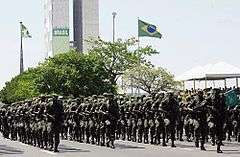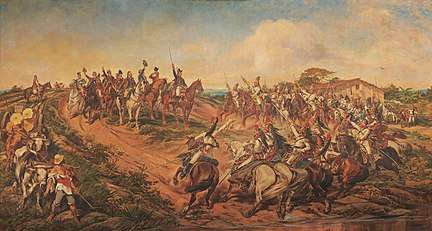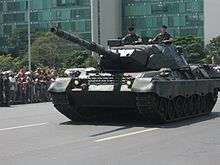Independence Day (Brazil)
The Independence Day of Brazil (Portuguese: Dia da Independência, Portuguese pronunciation: [ˈdʒi.ɐ dɐ ĩdepẽˈdẽsjɐ]), commonly called Sete de Setembro (Seventh of September, [ˈsɛtʃi dʒi seˈtẽbɾu]), is a national holiday observed in Brazil on 7 September of every year. The date celebrates Brazil's Declaration of Independence from the United Kingdom of Portugal, Brazil and the Algarves on 7 September 1822.
| Independence Day Dia da Independência | |
|---|---|
 Independence Day parade in Brasília | |
| Also called | Sete de Setembro (7 September) Dia da Pátria (Day of the Fatherland) |
| Observed by | Brazil |
| Type | National |
| Significance | The day of the Declaration of Independence of Brazil |
| Celebrations | Parades and concerts |
| Date | 7 September |
| Frequency | annual |
Background
In 1808, French troops commanded by Emperor Napoleon Bonaparte invaded Portugal as a retaliation for the Iberian country's refusal to participate in the trade embargo against the United Kingdom. Fleeing persecution, the Portuguese monarchs transferred the Portuguese Court from Lisbon to Rio de Janeiro, then capital of Colonial Brazil. In 1815, Prince Regent John VI created the United Kingdom of Portugal, Brazil and the Algarves, elevating Brazil to the rank of kingdom and increasing its administrative independence. Brazil, Portugal, and Great Britain were the three major contributors to the Independence of Brazil all three motivated by the circumstances peculiar to each.[1] Brazil's Independence was ultimately won through diplomacy after three years of war against Portugal.[1]
Origin

A political revolution erupted in Portugal in 1820, forcing the royal family to return. John VI's heir, Pedro, Prince of Brazil, remained in Brazil. In 1821, the Portuguese Assembly demanded Brazil to return to its former condition of colony and the return of the heir prince to Portugal. Pedro, influenced by the Rio de Janeiro Senate (Senado da Câmara) refused to return on 9 January 1822, a date which became known as Dia do Fico (I'll Stay Day).
On 2 September 1822, a new decree with Lisbon's demands arrived in Rio de Janeiro, while Prince Pedro was in São Paulo. Princess Maria Leopoldina, acting as Princess Regent, met with the Council of Ministers and decided to send her husband a letter advising him to proclaim Brazil's independence. The letter reached Prince Pedro on 7 September 1822. That same day, in a famous scene at the shore of the Ipiranga River, he declared the country's independence, ending 322 years of colonial dominance of Portugal over Brazil.[2] On the day of Prince Pedro's proclamation he was declaring a fact for the foundations of a new state had already been laid.[1] According to journalist Laurentino Gomes, who wrote a book about the event, Prince Pedro "could not wait for his arrival to São Paulo to announce the decision".[3] Gomes adds that "he was a reckless man in his decisions but he had the profile of leader that Brazil needed at the time, because there was no time to think".[3]
Observance
- Federal law N° 662, issued on 4 April 1949, made Independence Day a paid federal holiday.[4][5]
- Federal law N° 5.571, issued on 28 November 1969, established the protocol for the Independence Day celebration.[6]
Celebration
In Brazil
.jpg)
Independence Day is a national holiday marked by patriotic displays and military parades in most Brazilian cities.
In Brasília, the national celebration takes place at the Ministries Esplanade with a civil-military parade in the presence of the President of Brazil, who is Commander in Chief of the Armed Forces. Around 30,000 people attend the event each year, which costs about one million reais.[7][8] Similar military and civil parades are held in all the state capitals, and in many major cities throughout the country.
The national commemorations are broadcast on cable channel TV NBR and public TV station TV Brasil. In 2016, in honor of that year's Rio de Janeiro Summer Olympic Games, portions of that city's parade were aired on the channel. Until 1959 all national parades were held there as it was the former capital city. By 2017 TV NBR also began broadcasting snippets of the São Paulo parade, given that the city is the birthplace of the independent country.
Abroad
In New York City, the Brazilian Day is produced by João de Matos and held annually to celebrate the Independence Day.[9] The event takes place at 46th Street, near Times Square, in Manhattan.[10] The Brazilian Day concert is the centerpiece of the event, featuring famous Brazilian musicians, such as Daniela Mercury, Ivete Sangalo, Chitãozinho & Xororó, Skank, Sandy & Junior, Cláudia Leitte, and Banda Calypso. In 2008, the event drew a crowd of 1.5 million people, according to the New York City Police Department.[9] The Brazilian television network Globo sponsors the event and airs it live to Brazil and over 115 countries through Globo International Network.
Similar events are held in Deerfield Beach, Florida,[11] San Diego,[12] Toronto,[13] Los Angeles,[14] and London, United Kingdom.[15]
These events consist of a civil parade, concerts of Brazilian music and exhibitions of Brazilian dances and martial arts.
National Independence Day parade in Brasília
The national celebrations in the federal capital Brasília, held since 1960, are the biggest of all the parades held nationwide on this most important day for Brazilians. As already mentioned, the President of Brazil, in his/her constitutional mandate as Commander in Chief of the Armed Forces, is the chief guest for the parade held annually in the capital's Ministries Esplanade, taking the salute of a more than 9,000 to 24,000 strong civil-military contingent made up of civilians and servicemen and women of the armed forces, military police, military firefighters and civil law enforcement agencies representing all the states and territories of the republic, with a mobile column of around 90-700 vehicles, a medium mounted column and a big air flypast column of around 80-130 aircraft from the armed forces and civil security units. It is usually held in the mid-morning and is a nationally televised event. In recent years, the presidential grandstand is situated in front of the building of the Ministry of Defense along the avenue, as a remember of the constitutional mandate granted to the presidential office to oversee the Armed Forces and the reserve organizations. Right there, as well as on the stands along the north side of the avenue, alongside the general public and tourists visiting the capital on this special day the following dignitaries are also present:
- Vice President
- General Board of the National Congress and the Bureaux of the Senate and Chamber of Deputies, as well as select Deputies and Senators
- Cabinet ministers, deputy ministers and persons with ministerial status
- Chairman of the Institutional Security Office of Brazil
- Presidents and vice presidents of the judicial courts established by law
- The Chief of the Joint Staff of the Armed Forces, commanders of the service branches of the Armed Forces and commandants of the National Public Security Force, Federal District Military Police and Federal District Military Firefighters' Corps
- Heads of the Federal Police, Federal Railroad Police, Federal Highway Police, and the Civil Police of the Federal District
- Governor of the Federal District and the Speaker of the Legislative Chamber of the Federal District
- The diplomatic corps, foreign media representatives and military attaches
- Former Presidents, Vice Presidents and retired members of Congress and the judicial branch if present
- Veterans of the armed forces and civil security units
At 10am the parade's ground and mobile column assembled on the Esplanade present arms to honor the arrival of the President, who is received by the parade commander, a general officer of the Army with the rank of Lieutenant General holding the appointment of Commander of the Plantalto Military Command. Upon his arrival, the Brazilian National Anthem is played as a ceremonial gun section of the Cayenne Battery fires a 21-gun salute. Following this, the parade commander informs the president of the commencement of the parade inspection segment, and thus, as his/her vehicle, lead on by a motorcycle section of the Military Police, passes by all the parading units he/she salutes their respective unit color guards until all the units and the mobile column have been inspected.
The President then advances on the open-top vehicle, which then stops at the central grandstand. He/she departs from the vehicle and is welcomed by a ceremonial platoon of the 1st Guards Cavalry Regiment "Independence Dragoons" as he/she arrives there to meet the dignitaries. Following this, the regimental band sounds the "Continências ao Presidente da República", which are composed of the introduction and final chords of the Brazilian National Anthem, after the music stops the lancers depart and a color guard from the Ministry of Education of the Federal District arrive near the band, alongside the choir from the Military College of Brasilla, which positions near it.
Gallery
Independence Day military parade
 Air show in Brasília, 2005
Air show in Brasília, 2005 The Presidential Guard Battalion at the parade, 2007
The Presidential Guard Battalion at the parade, 2007 Leopard 1A5 main battle tank during the 2009 Independence Day military parade
Leopard 1A5 main battle tank during the 2009 Independence Day military parade.jpg) President Dilma Rousseff arrives for the event in the presidential Rolls-Royce
President Dilma Rousseff arrives for the event in the presidential Rolls-Royce.jpg) The Aerial Demonstration Squadron, popularly known as the Smoke Squadron.
The Aerial Demonstration Squadron, popularly known as the Smoke Squadron..jpg) 1st Guards Cavalry Regiment of the Army, known as the Independence Dragoons.
1st Guards Cavalry Regiment of the Army, known as the Independence Dragoons..jpg) A Boeing C-137 Stratoliner (retired in 2013) followed by four Northrop F-5 jets.
A Boeing C-137 Stratoliner (retired in 2013) followed by four Northrop F-5 jets. The Smoke Squadron
The Smoke Squadron.jpg) EE-9 Cascavel armoured vehicles
EE-9 Cascavel armoured vehicles.jpg) ASTROS 2020 multiple rocket launchers
ASTROS 2020 multiple rocket launchers.jpg)
.jpg) UAI M1-50 military trucks
UAI M1-50 military trucks.jpg) A KC-130, four A-29 Super Tucano light attack aircraft, and two Mirage 2000 jets
A KC-130, four A-29 Super Tucano light attack aircraft, and two Mirage 2000 jets.jpg) AAV-7A1 armored personnel carrier/assault amphibious
AAV-7A1 armored personnel carrier/assault amphibious
References
- (in Portuguese) "7 de Setembro – Dia da Independência" at the website of the Brazilian Institute of Geography and Statistics
Notes
- Manchester, Alan K. (1951). "The Recognition of Brazilian Independence". The Hispanic American Historical Review. 31 (1): 80–96. JSTOR 2509132.
- (in Portuguese) Sete de Setembro Prefeitura do Rio de Janeiro. Retrieved on 5 July 2009.
- Brasil, Ubiratan. "O impetuoso que o país precisava". O Estado de S. Paulo. 5 September 2010.
- (in Portuguese). Lei No 662, de 6 de Abril de 1949. Presidência da República. Retrieved on 5 July 2009.
- (in Portuguese) Decreto Nº 27.048 de 12 de Agosto de 1949. Presidência da República. Retrieved on 5 July 2009.
- (in Portuguese) Lei Nº 5.571, de 28 de Novembro de 1969. Soleis.adv.br. Retrieved on 5 July 2009.
- Menezes, Leilane. "30 mil pessoas devem assistir ao desfile de 7 de setembro na Esplanada". Correio Braziliense. 4 September 2010.
- "Festa de 7 de setembro vai custar quase R$ 1 milhão". O Globo. 2 September 2010.
- History of the Brazilian Day in NY Archived 3 September 2011 at the Wayback Machine Brazilian Day in New York. Retrieved on 13 July 2009.
- Kugel, Seth (6 August 2006). "The Last Samba of Summer". New York Times. Retrieved 13 July 2009.
- "Brazilian Day Florida". Brazilian Day Florida. Archived from the original on 7 January 2009. Retrieved 13 July 2009.
- Brazilian Day San Diego Brazilian Day San Diego. Retrieved on 13 July 2009.
- "Brazilian Day Canada". Retrieved on 7 September 2010.
- "Brazilian Day in L.A." Consulate General of Brazil. Archived from the original on 25 July 2011. Retrieved 13 July 2009.
- "Brazilian Day London". Brazilian Day London. Archived from the original on 3 August 2009. Retrieved 13 July 2009.